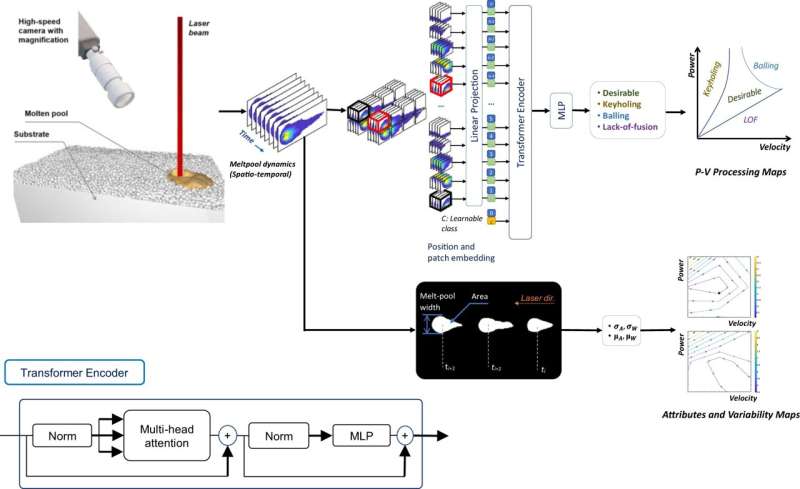
In order to successfully 3D-print a metal part to the exacting specifications that many in industry demand, process parameters—including printing speed, laser power, and layer thickness of the deposited material—must all be optimized.
But to develop additive manufacturing process maps that ensure those optimal results, researchers have had to rely upon conventional methods—lab experiments that use ex situ materials characterization to test parts that have been printed using various parameters. Testing so many combinations of parameters in order to develop the optimal process can be both time-consuming and expensive, especially considering the wide range of metals and alloys that can be used in additive manufacturing.
David Guirguis, Jack Beuth, and Conrad Tucker of Carnegie Mellon University Mechanical Engineering have developed a system using ultra high-speed in-situ imaging and vision transformers that can not only optimize those process parameters, but is also generalizable so that it can be applied to various metal alloys.
Their work is published in the journal Nature Communications.
Vision transformers are a form of machine learning that apply neural network architectures originally developed for natural language processing tasks to computer vision tasks such as image classification. The video vision transformers take that a step further by using video sequences instead of still images to capture both spatial and temporal relationships that enable the model to learn complex patterns and dependencies in video data.
The self-attention mechanism, which allows natural language processing models to weigh the importance of different words in a sequence, allows the model Guirguis created to weigh the importance of different parts of the input sequence for making predictions about the occurrence of defects.
"We needed to automate the process, but it can't be done with computer programming alone," explained Guirguis, a postdoctoral associate in mechanical engineering. "In order to capture the patterns, we need to apply machine learning."
"We are excited to have developed an AI method that leverages temporal features in AM imaging data to detect different types of defects. Demonstrating the generalizability of the AI method using different AM metals is groundbreaking and reveals that the same trained AI model can be employed without costly retraining using additional data," remarked Tucker, a professor of mechanical engineering.
Guirguis says he is fortunate to have had such strong training in machine learning at Carnegie Mellon because it is more important than ever that mechanical engineers know how to apply both experimental and computational solutions to the problems they solve.
In this case, Guirguis was trying to overcome the primary limitation of in-situ imaging of the laser powder bed fusion (LPBF) additive manufacturing process. The technology uses a high-power laser as an energy source to melt and fuse powders in specific locations to form certain shapes, a re-coater then spreads a new layer of powder, and the process repeats until 3D objects are formed.
But the molten metal seen by a camera during the printing process is saturated, so it's not possible to see its physical features, which can identify possible defects that can deteriorate the mechanical properties and reduce fatigue life of the printed part.
More information: David Guirguis et al, Accelerating process development for 3D printing of new metal alloys, Nature Communications (2024). DOI: 10.1038/s41467-024-44783-5. www.nature.com/articles/s41467-024-44783-5
Citation: AI accelerates process design for 3D printing metal alloys (2024, February 26) retrieved 26 February 2024 from https://techxplore.com/news/2024-02-ai-3d-metal-alloys.html
This document is subject to copyright. Apart from any fair dealing for the purpose of private study or research, no part may be reproduced without the written permission. The content is provided for information purposes only.
